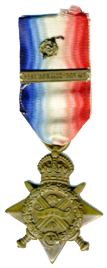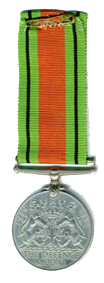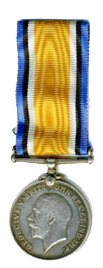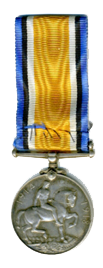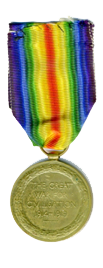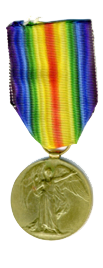
James Thomas Mitchell
MITCHELL, James: Military Career
What medals was James entitled to and why? What is the significance of the sphynx and the word "Egypt" on the regimental cap badge? What is the "Back" badge? These and other questions, answered here.
1914 Star | The Royal Gloucestershire Regiment Medals awarded to James Thomas Mitchell (1888-1942) (Click on each medal to go directly to details) | The Defence Medal (1939-1945) | |
| | |||
The Cap Badge of the Royal Gloucestershire Regiment | |||
The British War Medal 1914-1920 | The Victory Medal 1914-1919 | ||
The 1914 Star
The 1914 Star was a British campaign medal first authorised in 1917. It was awarded to all military personnel - including medical staff - who saw service in Belgium and France between 5 August and 22 November 1914. In October 1919, it was announced that those who had served 'under enemy fire' during this period were also to be issued a clasp in recognition of their deeds. A total of 365,622 1914 Stars and 145,000 Star clasps were awarded.The Defence Medal (1939-1945)
This cupro-nickel medal has the coinage head of King George VI with the usual legend on the obverse. The reverse shows the Royal Crown resting above a small oak tree and flanked by two heraldic lions. The dates 1939 and 1945, appear in the top left and right respectively, whilst beneath the design are the words THE DEFENCE MEDAL. The ribbon is flame coloured with green edges and symbolises the air attacks and destruction on our green land. The nationwide black-out is represented by a narrow black stripe down the centre of each of the green edges.
Generally speaking , this medal was awarded for three years service in Great Britain until 8th May 1945 or six months overseas in territories subjected to, or threatened by enemy attacks. The time was extended to forces overseas until 15th August 1945, the end of the war in the Pacific. In the case of mine and bomb disposal units the time qualification was three months.
Owing to the terms of reference for campaign awards it was not unusual to find a man with several stars who had never heard a shot fired in anger. Conversely, a man with only the Defence Medal who earned it, for example, whilst serving in the fire or rescue services in London or any other city subject to constant air attack, wears a medal worth having. In common with all other decorations and medals only the man who wears the medal knows how it was earned.
The British War Medal (1914-1920)
The British War Medal 1914-1920, authorised in 1919, was awarded to eligible service personnel and civilians alike. Qualification for the award varied slightly according to service. The basic requirement for army personnel and civilians was that they either entered a theatre of war, or rendered approved service overseas between 5 August 1914 and 11 November 1918. Service in Russia in 1919 and 1920 also qualified for the award.
The Victory Medal (1914-1919)
This medal commemorates some of the bloodiest battles that have ever been fought by British & Commonwealth troops. The medal was instituted by King George V in 1919 to mark the end of the First World War and record the service given. Although the First World War ended in 1918, the qualification period was extended to cover post-war mine clearance and service in Russia during 1919-20. A total of approximately 6,500,000 silver medals were issued.
The Royal Gloucestershire Regiment "Egypt" cap, shoulder and back badge
The Regiment, in 1801, the 28th Foot (North Gloucestershire) under the Command of General Sir Ralph Abercromby, landed in Egypt against strong French opposition. They marched onwards to Alexandria where they brought the French army to Battle.
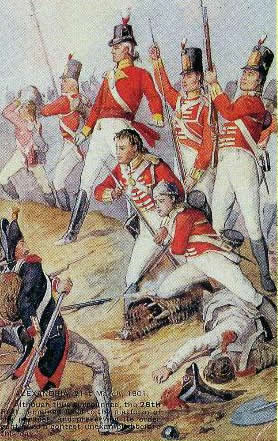
They took up a defensive position on a line of low sand hills. On their right was an old Roman fort, which stood on a slight rise close to the shore, and to the front of this was an unfinished redoubt, which was manned by the 28th. Between them, the fort and the redoubt formed the key position, for if either was taken, then the British flank could be turned.
Under the cover of the pre-dawn darkness and sand dunes, two columns of French infantry headed straight for the British right. Heavy fighting ensued and as more French columns joined the attack, the 28th. Became cut off. The British musketry drove off the French onslaught but a brigade of French infantry moved through the gap between the 28th. and the rest of the British line. A counter attack by the 42nd Foot drove off this attack but they in turn went too far and were themselves in danger from French cavalry. The battle raged all along the line, but nowhere as fiercely as on the right, with the 28th fighting to their front and flanks. More French cavalry joined in, supported by more infantry. Some of the cavalry broke through the 42nd and formed up to charge the 28th in the rear. With no reserves available at this critical point in the battle, Lt. Col. Chambers, who had taken over command following the serious wounding of the C.O. Col. Paget, gave the historic order "Rear rank, 28th! Right about face!"
The rear ranks turned and with exemplary discipline waited until the French cavalry were a few horse lengths away. They then fired one devastating volley, causing heavy casualties amongst the cavalry and forcing them to withdraw.
For their gallantry in fighting back to back, the Regiment was given the unique honour of wearing a badge at the back of their caps.
The Battle Honour 'Egypt', with the Sphinx, together with the laurel leaves of victory, are also borne on the Regimental Colour. Cap badges fore and aft are worn to this day by soldiers of The Royal Gloucestershire, Berkshire & Wiltshire Light Infantry.
James Mitchell's Medal Card
<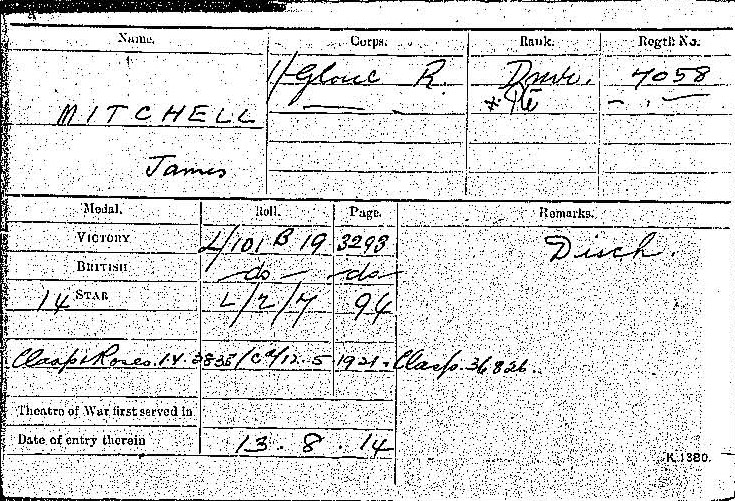
The above scan is taken from the original record card held at The National Archives in Kew, England and is all that remains of the military record of James. Many millions of WW1 records (around 70% of the total archive), were destroyed during the blitz on London, in the Second World War.
The name "MITCHELL James" can clearly be seen along with his regimental number "7058". The Corps is entered as "1/Gloucs R", meaning the 1st Gloucestershire Regiment, and Rank, entered as "Drmr - Pte" refers to Drummer - Private. The title of "Drummer" was usually bestowed upon under-age recruits to ensure that they would not face hostile action.
Below this can be seen the entitlement to medals. Three columns indicate the medal, the roll number and page within the roll. Below that can be seen the addition of the clasp and rose added to the 1914 star on 12 May 1921.
Unfortunately, there is no entry under "Theatre of War first served in" but it is likely that this would have probably been France or Belgium. The date is clear however... 13.8.14, 13th August 1914.
Finally, in the box headed Remarks, is the word "Disch" This is an abbreviation for Discharged. This indicated that James survived the war (which we know already). Had he not, the entry would probably read something like... "Killed in Action" or "Missing in Action"
| Owner/Source | RM |
| Date | 20/11/2006 |
| Linked to | James Thomas Mitchell |













